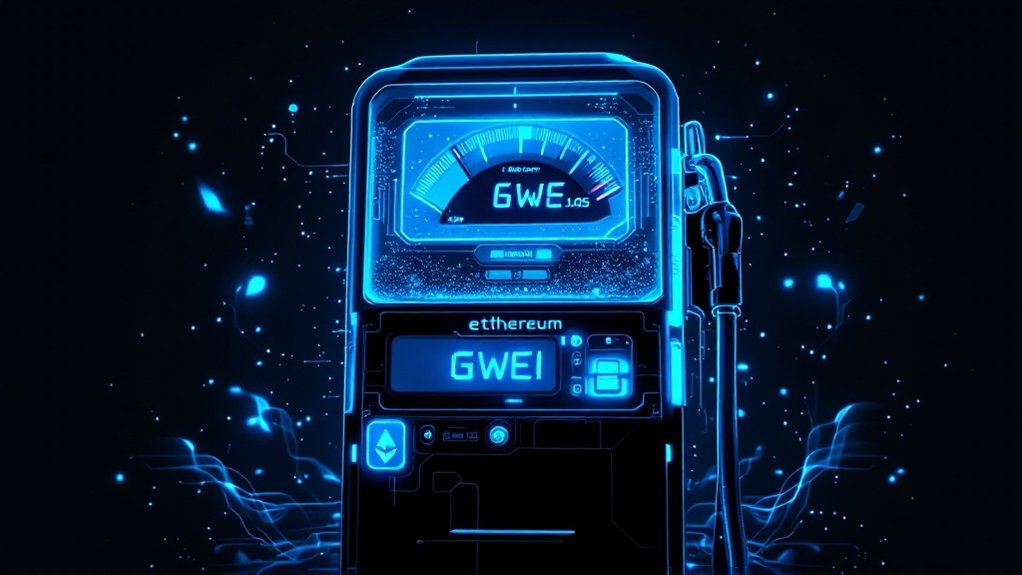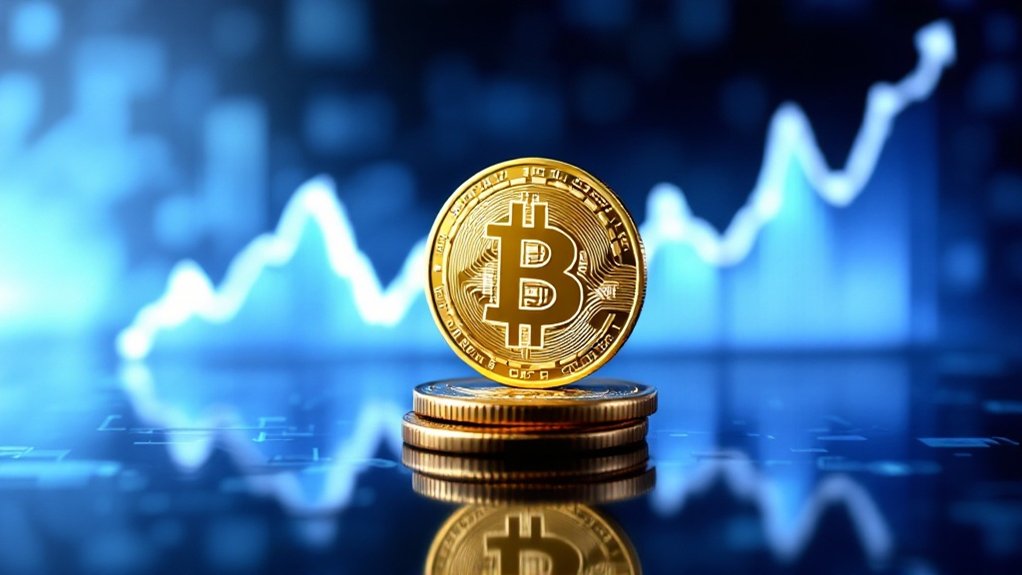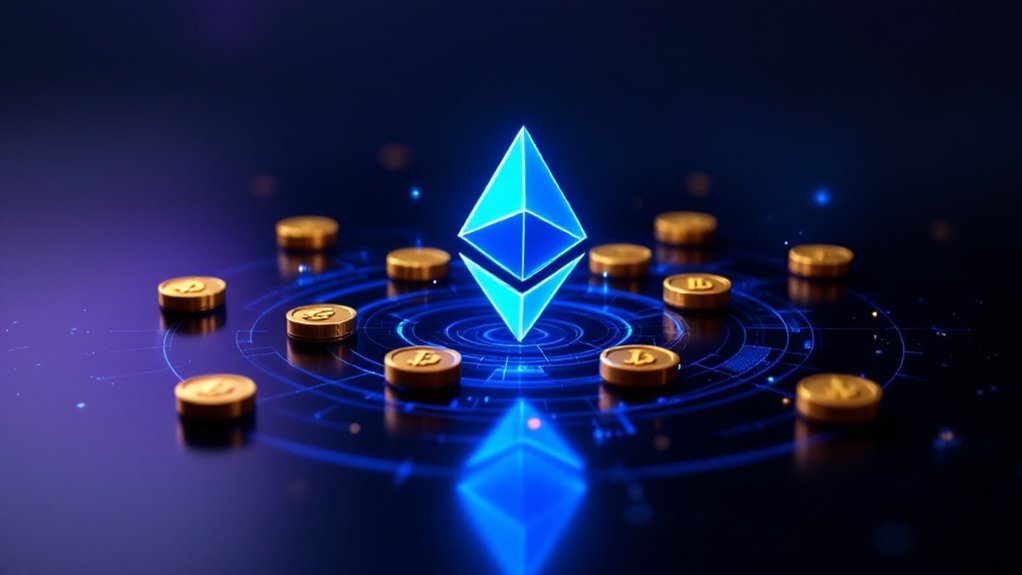Gwei is the standard unit for measuring Ethereum gas fees, representing one billionth of an Ether (ETH). This denomination allows users to express transaction costs without using lengthy decimals. Under the EIP-1559 mechanism, fees fluctuate based on network congestion. Validators receive these payments as compensation for transaction verification and computational resources. Understanding Gwei helps users make informed decisions about timing transactions, especially during high-activity periods when costs increase substantially. Further exploration reveals how this system maintains Ethereum's operational integrity.

Network congestion significantly influences gas fees, with busier periods demanding higher payments.
Transaction complexity also plays a vital role, as more computationally intensive operations require more gas to execute. The implementation of Ethereum Improvement Proposal 1559 (EIP-1559) in recent years has created a more predictable fee structure, though prices can still fluctuate substantially during peak usage. Gas fees serve as network validator incentives to process and verify transactions securely on the blockchain.
Complex transactions demand higher gas, while EIP-1559 has improved predictability despite peak-time fluctuations.
Industry experts recommend several strategies to manage gas costs effectively. "Timing transactions during off-peak hours can reduce fees by up to 30%," notes a recent analysis by blockchain analytics firm Messari. Users can also employ gas price estimators to optimize their fee settings and consider utilizing layer 2 scaling solutions that process transactions at a fraction of the cost. Gas fees are calculated in Gwei units, with 1 ETH equaling 1 billion Gwei.
Gas fees have profound implications for the Ethereum ecosystem. They serve as a barrier to entry for small transactions while simultaneously incentivizing efficient smart contract design. The fee structure has driven significant innovation in scaling solutions and more gas-efficient code development practices. With the transition to Ethereum 2.0, validators now receive gas fees through Proof of Stake rather than miners under the previous system.
Looking forward to 2025 and beyond, ongoing research into sharding and other scaling technologies promises to reduce fees further.
Meanwhile, increased adoption of layer 2 solutions and the continued transition to Ethereum 2.0 are expected to improve network efficiency and potentially lower costs for users across the ecosystem.
Frequently Asked Questions
How Can I Reduce Ethereum Gas Fees?
To reduce Ethereum gas fees, users should utilize Layer 2 solutions like Optimistic rollups or ZK-rollups.
Transaction timing matters; weekends and early UTC hours typically offer lower fees.
Batch transactions whenever possible to combine multiple operations.
Alternative networks like Binance Smart Chain and Solana provide more cost-effective options.
Gas prediction tools help identify ideal transaction windows.
Setting custom gas prices in wallets like MetaMask enables greater control over transaction costs.
What Time of Day Are Gas Fees Lowest?
Ethereum gas fees typically reach their lowest points during weekend mornings, particularly on Sundays between 2 AM and 3 AM EST.
Weekday transactions are most economical from midnight to 4 AM EST, with 1-3 AM showing consistent fee reductions.
Network congestion decreases during these off-peak hours due to reduced global activity.
Holiday weekends often present extended periods of lower gas prices, while major crypto events can temporarily disrupt these patterns.
Can Gas Fees Exceed the Value of My Transaction?
Gas fees can indeed exceed transaction values, particularly for small-value transfers. This phenomenon occurs frequently with microtransactions under $10, where network congestion can drive fees to disproportionate levels.
NFT minting and DeFi interactions are especially vulnerable to this issue. Users should employ gas fee calculators to estimate costs before proceeding.
Layer 2 solutions offer alternatives with substantially lower fees, making smaller transactions economically viable during periods of high mainnet congestion.
Will Ethereum 2.0 Eliminate Gas Fees Completely?
Ethereum 2.0 will not eliminate gas fees completely.
While the upgrade significantly improves scalability through sharding and proof-of-stake consensus, gas fees remain necessary to prevent network spam and prioritize transactions.
EIP-1559 and Layer 2 solutions will reduce costs substantially, but a fee market must exist to maintain network security.
The complete elimination of fees would create vulnerability to denial-of-service attacks and undermine validator incentives in the ecosystem.
How Do Gas Fees Compare Between Different Blockchains?
Blockchain gas fees vary significantly across networks. Ethereum charges moderate fees (averaging $0.53) using gwei units, while Bitcoin fees are higher ($1.5-$2) measured in satoshis.
Solana offers extremely low fees at $0.00025 per transaction with faster processing. Other low-fee alternatives include Nano and IOTA with zero transaction costs, while TRON, XRP, and Stellar maintain fees below $0.0001.
Network congestion and consensus mechanisms primarily influence fee structures across these platforms.
References
- https://coinrule.com/blog/learn/eth-gas-fees-guide-2025-how-to-manage-ethereum-transaction-costs/
- https://transak.com/blog/what-are-ethereum-gas-fees-and-gwei
- https://tokentax.co/blog/are-ethereum-gas-fees-tax-deductible
- https://volet.com/blog/post/understanding-what-is-gwei-and-how-it-works-in-ethereum-transactions-01jj7fpkss3f86qr882f5129y2
- https://www.britannica.com/money/ethereum-gas-fees-eth
- https://nowpayments.io/blog/understanding-gwei
- https://etherworld.co/2025/03/04/the-hidden-challenges-of-ethereum-gas-fees-and-how-devs-are-solving-it/
- https://www.investopedia.com/terms/g/gwei-ethereum.asp
- https://www.cryptovantage.com/guides/what-are-ethereum-gas-fees/
- https://www.risein.com/blog/what-is-gwei





